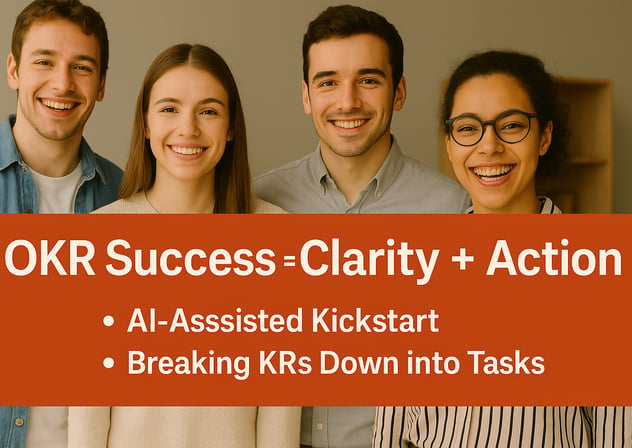I Watched a Team Stop Spinning and Start Executing
A look at what changed when one team shifted from vague OKRs to real work.
OKRS & EXECUTIONAI FOR BUSINESS OPS
Rui Luis
5/23/20252 min read


🚀 The $5M Climb: What I Saw Happen When a SaaS Team Got Serious About Execution
Some stories are best told from the outside.
This one starts with a company I’ve been loosely advising — a SaaS business that hit $1M in MRR, was growing steadily, and had their sights set on $5M.
They had a solid product, real traction, and a motivated team.
What they didn’t have — yet — was clarity around execution.
❌ The Early OKR Pattern: Lots of Alignment, Little Movement
They had OKRs. Plenty of them.
The typical kind:
Objective: Accelerate Mid-Market Growth
Key Results: Improve win rate. Expand outbound. Reduce churn.
Ambitious? Definitely.
Helpful? Not really.
Check-ins were polite but vague. Progress updates were more narrative than data. Teams nodded along, then returned to their Jira boards with no clear connection to the strategy.
I didn’t offer a complete system. I just asked one question:
“If this Key Result were completed, what exactly would be done?”
The room got quiet. That was the first turning point.
🔄 The Shift: Clearer Thinking → Better Output
What changed wasn't flashy — just more deliberate:
1. They started with clearer, more behavior-based KRs
Not “Improve onboarding,” but:
Run 10 user interviews
Launch new welcome email flow
Reduce time-to-value to 3 minutes
Small change. Big difference.
2. They started breaking things down immediately
Every new KR became a working doc.
“What needs to happen?” → turned into tasks.
Tasks went into actual systems.
Work moved faster — and more visibly.
No ceremonies. No consultants. Just a shift in clarity.
📈 What Followed
They didn’t move overnight. But they moved with intention.
Churn ticked down
Sales motion sped up
The product team had sharper focus
By the end of Q4, they’d reached $3.3M MRR — well ahead of their internal forecast.
More importantly:
Team meetings got shorter.
Check-ins got real.
People stopped asking, “Are we on track?” and started saying, “This is done.”
🧠 What I Took From Watching This
OKRs don’t fail because they’re wrong.
They fail because they don’t translate into work.
You don’t need better goals.
You need clearer outcomes — and fewer gaps between intent and action.
That’s where this team found traction.
Not in strategy decks. But in the rhythm of small, unambiguous execution.
👋 PS — If You’re Trying to Do the Same…
I’ve been part of building something for teams who want fewer spreadsheets and more momentum.
We’re quietly giving early teams access right now — no pitch, just a simple starting point.
📍 Try it free for 14 days → okrfocuspro.com
©Plan Focus Inc. 2025. All rights reserved.
Smarter Strategy. Unified Execution.
Empowering teams to plan, track, and execute with proven templates, an interactive OKR dashboard, and expert-level support — all for just $500/month.
